PinotFile: 10.39 October 1, 2016
|
The French Continue to Blaze New Wine Trails in Oregon
Explorers Jean-Francois de Galoup Comte de La Pérouse (1741-1788) and Eugéne Duflot de Mofras (1810-1884) mapped and documented the western coast of North American including Oregon. Benjamin Louis Eulalie de Bonneville (1796-1878) was a French-born officer in the United States Army who blazed portions of the Oregon Trail during his expeditions to Oregon Country. The twentieth century has brought a new wave of French to Oregon, this time a group of accomplished winegrowers and winemakers who see the potential in Oregon for the finest Pinot Noir outside of Burgundy. Robert Drouhin, the Chairperson of Maison Joseph Drouhin from 1957 to 2003, established the first Burgundy presence in Oregon in 1987, Domaine Drouhin Oregon (Veronique Drouhin-Boss). Several others followed in recent years, including Domaine des Comtes Lafon (Dominique Lafon, Evening Land Vineyards, 2007), Domaine Marc Roy (Alexandrine Roy, 2007), Comte Louis-Michel Liger-Belair (Chapter 24 Vineyards, 2012), Maison Louis Jadot (Jacques Lardière, Résonance, 2013), Domaine Méo-Camuzet (Jean-Nicolas Méo, Nicolas-Jay, 2014). Why Oregon and not California? Well, the French have always had a close relationship with Oregon, beginning with the early Oregon vintners such as David Lett, Charles Coury, and David Adelsheim, who traveled to Burgundy to study and established relationships and that laid the ground work for future affiliations. Oregonians have always relished Burgundian influence, and the Burgundians in turn have participated with regularity in the Steamboat Conference and the International Pinot Noir Celebration. The midpoint of the Willamette Valley lies at 45 degrees north latitude, the same as for Burgundy’s Cote d’Or and thus vintages in Oregon tend to parallel those in Burgundy. Speaking frankly, the French often dismiss California’s climate as too hot for Pinot Noir, finding more value in savoriness, structure and texture felt to be lacking in many California fruit-driven wines. Finally, although recent investments in Oregon vineyard land have pushed up prices, the cost of vineyards is still less than California and considerably less than Grand Cru Burgundy plots. The French are intrigued with the opportunity in Oregon because as Jean-Nicolas Méo has noted, they are excited by the idea of taking what they have learned from the grands and premier crus of Burgundy and applying it to a new region, a new climate, new soils and new vineyards. There also is the attraction of building something meaningful from scratch. There are few opportunities in Burgundy to grow and launch new projects. This article will give a short synopsis of each French contribution to the Oregon Pinot Noir scene and a sample wine will be reviewed. A wine from Domaine Roy & Fils is included since it is modeled after a Burgundy domaine although it has no French-born ownership or French winemaker. Canadian-born Marc-Andrè lives in France and heads construction company Sotramont that his father, Robert Roy, started. This winery began in 2012 with partners Marc-André Roy and winemaker Jared Etzel, whose fathers partnered to start Beaux Frères Winery in 1991. There are several other French-born winemakers currently working in the Willamette Valley. They are all highly visible and accomplished, and include the following (I did not intentionally mean to exclude any names). Delphine Gladhart, Winter’s Hill Vineyards. A winemaking job at Lemelson Winery in 2001 led to a meeting with future spouse Russell Gladhart whose family owned Winter’s Hill Vineyards in the Dundee Hills where she became the winemaker. Isabelle Meunier, Elton Winery, Lavinea Winery. She initially came to Oregon in 2007 to oversee Evening Land Vineyards winemaking for Dominique Lafon, leaving that winery in 2014. She is now the consulting winemaker for Willamette Valley Vineyards new Elton Winery debuting with 2015 vintage. Her own label, Lavinea Winery, features single-vineyard wines. Isabelle Dutartre, De Ponte Cellars and 1789 Wines. Isabelle worked with Véronique Drouhin-Boss in Burgundy, followed Véronique to Oregon in 1989, worked with her in Oregon and Beaune for many years, and became head winemaker at De Ponte Cellars in 2001. Laurent Montalieu, owner and winemaker for Hyland Estates and Soléna Estate and NW Wine Company. Laurent is a Bordeaux native who has been making wine in Oregon for over 28 years in Oregon. Gilles de Domingo, Cooper Mountain Vineyards. Gilles is a French-born winemaker, trained in Bordeaux, France, who made wine throughout the world before settling in the Willamette Valley. Florent-Pierre Merlier, Van Duzer Vineyards. “Flo” is a native of Burgundy who found romance with Krista, an Oregonian, while the two were interning at the same winery in Burgundy. Florent then obtained his Diploma of Viticulture from the University of Dijon before relocating to Oregon in 2009, and becoming the winemaker at Van Duzer in 2011. Jacques Tardy, Torii Mor Winery. Jacques represents the eighth generation of a Burgundian winemaking family from Nuits-Saint-Georges. After studying viticulture and enology at Lycee Viticole de Beaune, he moved to California in 1982. By 1990 he had made his way to Oregon and joined Torii Mor Winery as head winemaker in 2004.
Domaine Drouhin Oregon, Dundee Hills, OregonRobert Drouhin, the Chairperson of Maison Joseph Drouhin from 1957 to 2003 visited California in 1961. He met with Robert Mondavi who suggested investing in California, but Robert Drouhin’s interest was Pinot Noir and California had not achieved success with that variety then. He realized he would have to look elsewhere. In 1979, Robert Drouhin set up a blind tasting of French Burgundies versus their American Pinot Noir counterparts. At this now famous Gault-Mileu tasting held in Paris, a 1959 Domaine Drouhin Chambolle- Musigny came in first, but David Lett’s 1975 The Eyrie Vineyards South Block Reserve took second. This impressed Robert who was struck by the resemblance of the Willamette Valley to the Côte d’Or and the wines produced by Oregon’s pioneering Pinot Noir winemakers. Robert initiated the purchase of 100 acres in the Dundee Hills overlooking the town of Dundee by Maison Joseph Drouhin in 1987, making the Drouhin family the first Burgundian winemakers to invest in Oregon. Robert chose his daughter, Véronique, part of the fourth generation of the Drouhin family and a 1985 graduate of the University of Dijon, to direct the new project in Oregon known as Domaine Drouhin Oregon. Véronique oversaw the initial planting of high-density vineyards in 1988, and crafted the first three vintages, 1988 to 1990, from purchased grapes. More land was acquired bringing the total to 225 estate acres, 90 of that planted to Pinot Noir and Chardonnay. Veronique-Boss Drouhin is a long distance winemaker, continuing to live in Beaune, but traveling to Oregon frequently to oversee the winemaking at Domaine Drouhin Oregon. Phillipe Drouhin, Véronique’s brother, has managed the vineyards that are among the most densely planted in the United States from the beginning. Domaine Drouhin Oregon is one of the few vineyards in the United States to cultivate their own rootstocks and propagate all their own plant material by selection massale. The Pinot Noirs of Domaine Drouhin Oregon have set a benchmark for Oregon, emphasizing balance and elegance over extraction and power. Although they can be quite charming upon release, the wines age magnificently. Véronique told me, “My stylistic goal in Oregon is to produce very elegant wines. It is more of a challenge in Oregon than in Burgundy. In both regions, the goal is the same but the challenges are different. In Oregon it is pretty easy to produce wine with both good color and structure, but to capture the finesse is more tricky. In Burgundy, it is easy to obtain a natural elegance, but sometimes more challenging to get enough color and structure.” In December 2013, the Drouhin family more than doubled their Oregon vineyard holdings with the purchase of the 279-acre (111 acres planted) RoseRock Vineyard in the Eola-Amity Hills AVA. For more information, visit www.roserockoregon.com and www.domainedrouhinoregon.com.
2014 RoseRock Drouhin Oregon Eola-Amity Hills Oregon Pinot Noir 14.1% alc., $37. First bottling from Domaine Drouhin’s new acquisition, RoseRock Vineyard. This wine is a cuvée selection from the estate vineyard’s 35 blocks that are individually fermented. Vineyard is farmed sustainably by Phillipe Drouhin. Winemaker is Véronique-Boss Drouhin. · Moderately dark reddish purple color in the glass. Inspiring aromas of black cherry, blueberry, sous-bois and shaved oak. Rather bold and ripely fruited that is reflective of the vintage, with flavors of black cherry and blueberry-pomegranate. Velvety in the mouth with complimentary oak in the background, firm tannins, and a generous, slightly astringent finish. Score: 91
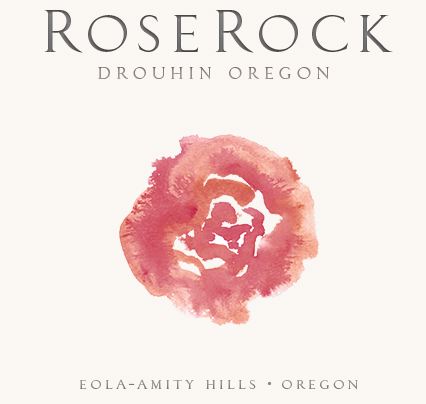
Evening Land Vineyards, Salem, OregonThe history of this winery is very complicated. Mark Tarlov, a former attorney and Hollywood producer and director, along with several partners including Danny Meyer of Union Square Hospitality Group, the Prieur family of Domaine Jacques Prieur, sommelier Larry Stone, and Dorothy Cann Hamilton, the CEO of the James Beard Foundation, established Evening Land Vineyards in 2005 with the purchase of Occidental Vineyard on California’s Sonoma Coast. The name Evening Land Vineyards was inspired by Homer’s ideal mythical garden where the fruits of immortality grew, the final chapter of Homer’s Odyssey. Evening Land eventually owned two vineyards in California (the 40-acre Wind Harp Vineyard in the westernmost reaches of the Sta. Rita Hills and the 3.5-acre Occidental Vineyard in the Sonoma Coast), but the centerpiece of the winery was the Seven Springs Vineyard in the Eola-Amity Hills that was secured with a 45- year lease in 2007. The 100-acre Seven Springs Vineyard, first planted in 1982, was a revered vineyard that was a source of wines for many esteemed producers in Oregon. Due to the lease arrangement, all grapes were consigned to Evening Land Vineyards after the 2008 vintage. A new label, Seven Springs Vineyard, was created for wines from the estate vineyard, and Evening Land remained the name for wines made from sourced grapes. Vigneron Dominque Lafon of Domaine des Comtes Lafon joined the project as consulting winemaker. He declined to make Pinot Noir from California, claiming the wines were too extracted and high in alcohol. The California wines were crafted by Sashi Moorman in Lompoc, and Lafon worked with winemaker Isabelle Meunier to produce the Oregon Chardonnays and Pinot Noirs. Meunier oversaw the conversion of Seven Springs Vineyard to biodynamic viticulture and overtook responsibility for the company’s Sonoma Coast wines in 2012. Winemaker Christophe Vial produced wines in Beaune that were also part of the portfolio. Founder Mark Tarlov left Evening Land Vineyards in January 2012 as did general manager Larry Stone. The winemaking team remained intact initially. In the summer of 2012, Evening Land Vineyards sold its Sta. Rita Hills acreage to winemaker Sashi Moorman, sommelier Rajat Parr and their business partners. Moorman and Parr introduced their own estate label, Domaine de la Côte. In 2014, Moorman, Parr and Charles Banks of Terroir Selections became minority partners in Evening Land Vineyards and took over operations. Winemaker Ian Burch, who had been assistant winemaker in both Beaune and Oregon, replaced Isabelle Meunier. Whetstone Wine Cellars winemaker Jamey Whetstone was hired in 2014 to be winemaker for Evening Land Vineyards’ Sonoma Coast operations. It would appear that Evening Land Vineyards is an estate producer completely focused on Seven Springs Vineyard and the Eola-Amity Hills led by winemakers Rajat Parr and Sashi Moorman since the 2014 vintage. A second label, Salem Wine Co., was started with the 2014 vintage offering Eola-Amity Hills Gamay Noir and Eola-Amity Hills Rosé of Pinot Noir. I do not know if Dominique Lafon remains as a consultant for the winery. The wines have had a pricing based on a color coded system with a range from blue, silver, gold and white labels, with white being the most expensive and blue the least expensive. The Chardonnays from Seven Springs Vineyard have set a benchmark for Oregon. The 2012 Seven Springs Vineyard La Source Pinot Noir received a score of 98 points and was #3 on Wine Spectator’s 2015 Top 100 List. A tasting room is located in Dundee at 1326 N Hwy 99W and is open daily. Vineyard tours are available by appointment. Visit www.elvwines.com.
2013 Seven Springs Vineyards Eola-Amity Hills Oregon Pinot Noir 13.0% alc., 2,469 cases, $40. Released fall 2015. The only bottling in the Evening Land Vineyards 2013 lineup to include non-estate fruit. Sourced from three vineyards within the Eola-Amity Hills (young vines Seven Springs, Rocky Hill and Eola Springs vineyards). Following a 4 to 5-day cold soak, there is a feral fermentation in open-top oak and concrete fermenters. Aged in neutral French oak barrels. · Moderately light reddish purple color in the glass. Aromatically charming with scents of cherry, spice and sandalwood. Light to medium in weight, with flavors of cherry and boysenberry, backed by a hint of oak seasoning. Elegant in style with a dry, lengthy finish. Score: 89
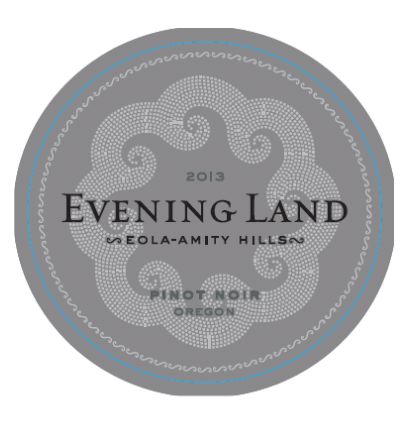
Phelps Creek Vineyards, Hood River, OregonRobert Morus founded Phelps Creek Vineyards to focus on estate grown Pinot Noir and Chardonnay. The estate vineyard consists of 30 acres of self-rooted and grafted Pinot Noir and Chardonnay, with initial plantings of Pinot Noir dating to 1990 and Dijon clone Chardonnay to 1992. Today, there are 25 acres of Pommard, 777 and 115 clones of Pinot Noir, 4.5 acres of Dijon clone 75 and 76 with a few vines of Wente clone, and .5 acres of Pinot Gris. Alexandrine Roy, who crafts the wines at her family’s Domaine Marc Roy in Gevrey-Chambertain, became a contributing winemaker at Phelps Creek initially in 2007, crafting a special reserve Cuvée Alexandrine, eventually assuming the role of Director of Winemaking in charge of all wine production beginning with the 2012 vintage. A fourth generation Burgundian winemaker, Alexandrine flies to Oregon three or four times a year to oversee the estate’s winemaking.
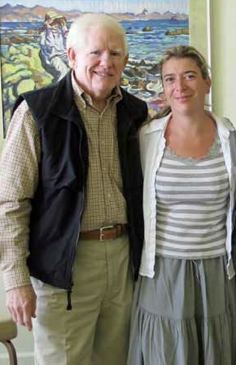 The winery’s current 5,000 case production includes Cuvée Alexandrine, a reserve level estate Pinot Noir. Robert continues his duties as a captain flying B-777s internationally for Delta Airlines. Visit www.phelpscreekvineyards. A tasting room in Hood River is open daily. I have known Alexandrine for several years as she attends the International Pinot Noir Celebration every year. I greatly admire her Domaine Marc Roy wines, and have developed a fondness for the Phelps Creek Vineyards wines as well.
2013 Phelps Creek Vineyards Cuvée Alexandrine Columbia Gorge Oregon Pinot Noir 13.5% alc., 244 cases, $54. A selection of the finest estate barrels. · Moderately light reddish purple color in the glass. Aromas of cherry, cranberry, petrol and cigar smoke lead to a light to mid weight wine offering delicate, even shallow, flavors of cherry and red berries. The tannins are firm yet silky, making for easy drink ability. The oak treatment stands out a bit and the finish is pleasant but modest. This bottling is usually a stunner, but this bottle was not as good as another previously reviewed. Score: 89
Chapter 24 Vineyards, Dundee, OregonThis winery takes its name from the Last Chapter of Homer’s The Odyssey. Mark Tarlov, formerly an owner of Evening Land Vineyards, launched this winery in 2012. He brought on Burgundian vigneron Louis-Michel Liger- Belair as a consultant to work with winemaker Mike D. “Mikey” Etzek, the son of Beaux Fréres winemaker Michael Etzel. Max Marriott, who worked for Louis-Michel in Burgundy as well as at Cristom in 2012, took over as winemaker, finishing the 2013 vintage and crafting the 2014 vintage. Domaine du Comte Liger-Belair was created in 2000 by Louis-Michel Liger-Belair, but the Liger-Belair family’s winemaking roots extend back to 1815. The Domaine’s holdings include the smallest appellation in France, the renowned Grand Cru of La Romanée. Louis-Michel’s emphasis is on the vineyard, and his background in agricultural engineering has brought to bear highly esteemed wines that have revitalized the storied family name. Tarlov plans to build a winery and acquire vineyards in the Willamette Valley while signing long-term contracts with several other vineyards. Currently, Chapter 24 produces wines from 48 vineyard sites. Ryan Hannaford, the former vineyard manager at Seven Springs Vineyard, joined the team as company viticulturist to assist with grower liaison and the biodynamic management of two leased vineyards. There are multiple vineyard sources from all six appellations. The label, Fire+Flood offers The Fire and The Flood, that explore the two main soil types in the Willamette Valley, Jory (Fire) and Willakenzie (Flood). The highest priced release is labeled Last Chapter, which was the highest rated Pinot Noir in America in 2014. By 2015, production was 12,000 cases, the majority of which was made for the second label, Maison l’Envoyés Two Messengers and Attaché Pinot Noirs. The Fire+Flood tasting room in open Friday-Sunday in Newberg, and other days by appointment. Visit www.chapter24vineyards.com.
2013 Chapter 24 Vineyards Fire + Flood The Flood Willamette Valley Oregon Pinot Noir 12.68% alc., 800 cases, $60. Sourced from four vineyards (Shea, Croft, DDL and Stardance). 100% de-stemmed, feral yeast fermentation lasting 23 days. Aged 12 months in French oak barrels, 50% new. · Moderate reddish purple color in the glass. Gorgeous perfume of fresh black cherries and lacy oak. Silky and polished on the palate, even sexy like a Pinot with curves. Flavors of black cherry, black raspberry and savory herbs with a noticeable oak overlay. Impressive harmony and thoroughly enjoyable, but not up to the 2012 bottling that was other worldly. Score: 92
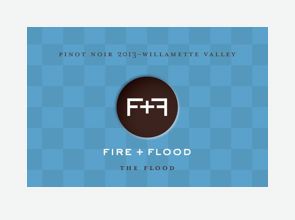
Nicolas-Jay, Newberg, OregonJay Boberg first met Burgundian winemaker Jean-Nicolas Méo 30 years ago when they attended the same university in the United States. They remained friends over the ensuing years as Jean-Nicolas took over as the winemaker at his family’s Domaine Méo-Camuzet in Burgundy, where he was mentored by legendary winemaker Henri Jayer who was a leaseholder in the family estate. His style of balance and finesse, fruit and elegance rather than stalkiness and tannin, catapulted Méo-Camuzet to fame. Jay carved out his own success as cofounder of the indie record label IRS Records, and later as president of MCA/Universal Records. As he began winding down his full time role in the music industry, he approached Jean-Nicolas about starting a winery together in the Willamette Valley. Jean-Nicolas now spends nearly two months in Oregon each season, traveling to the region throughout spring, summer and harvest to oversee the viticulture and winemaking. Jay spends up to six months each year in Oregon working in the vineyards and winery alongside Jean-Nicolas and the winery’s associate winemaker, Tracy Kendall. The winery’s Pinot Noir is made using grapes from the estate Bishop Creek Vineyard located in the Yamhill- Carlton AVA, as well as grapes from other top Willamette Valley vineyards such as Nysa, Momtazi and Zenith. The 13.5-acre Bishop Creek Vineyard includes 11 acres of clone 777, Wädenswil, Pommard and 667, with the majority planted in 1988 and 1990 that are own-rooted. The youngest plantings are from 2002. Since the vineyard was acquired in 2014, it has been farmed organically. Jay and Jean-Nicolas are pictured below at Bishop Creek Vineyard.
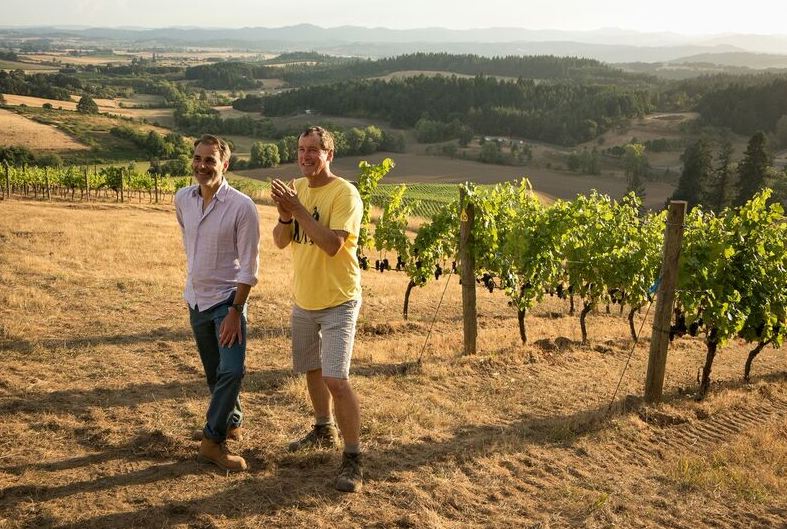 The winery’s website is www.nicolas-jay.com.
2014 Nicolas-Jay Willamette Valley Oregon Pinot Noir 13.5% alc., pH 3.63, TA 0.56, 1,691 cases, $65. Released April 2015. 100% de-stemmed, 5 to 7-day cold soak, slow native fermentation, pump-overs early on to accentuate weight, body and flavor while keeping berries intact and reducing the influence of seed and skin tannins, followed later in fermentation when close to dry by punchp-downs to build tannic structure. The wine was aged 15 months in French oak barrels, the same coopers and barrels that Jean-Nicolas selects for his Méo-Camuzet wines, 33% new. Bottled unfined and unfiltered. · Moderate reddish purple color in the glass. Complex aromatic profile offering scents of dark red cherries and berries, sandstone and savory herbs. The silky texture is mesmerizing and clearly the most outstanding feature of this wine. Mid weight plus in style, with flavors of purple and black fruits that make an impression on the attack and carry through to a persistent finish that slips off the back of the palate. When tasted the following day from a previously opened and re-corked bottle, the balance was clearly admirable, the seductive texture pleasing, and the finish was remarkably long. Score: 93
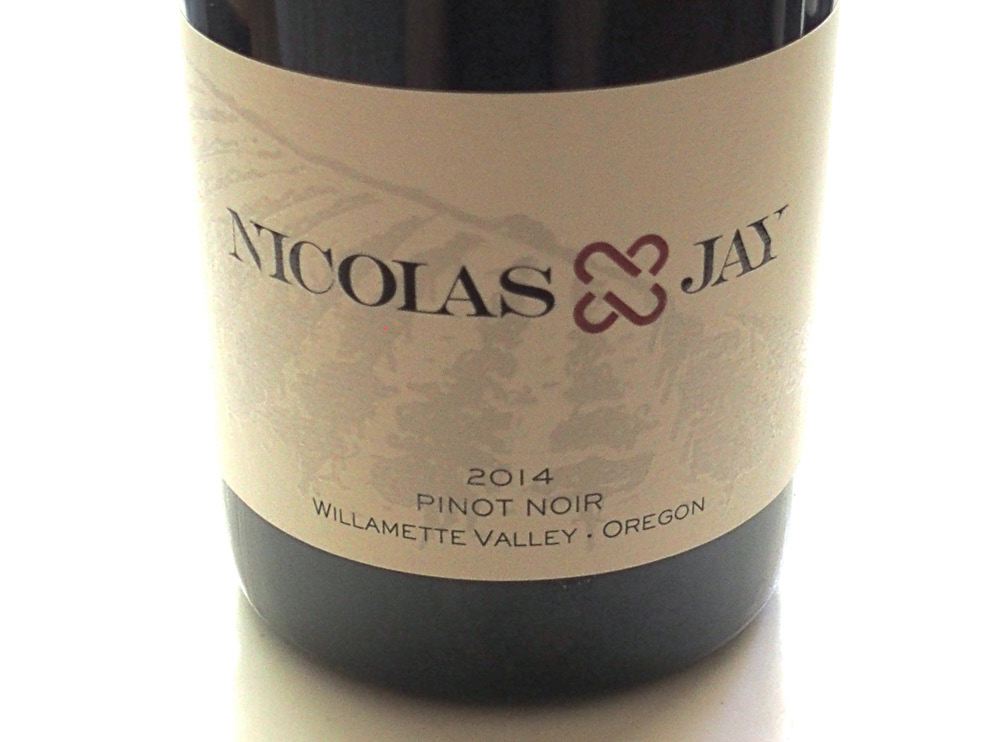
Résonance, Newberg, OregonJacques Lardière was the winemaker at Maison Louis Jadot for 42 vintages, handing over the reigns in 2013 to Thibault Gagey, the son of Pierre-Henry Gagey, the president of Louis Jadot. Jadot had decided to invest outside Burgundy to expand its business and chose Oregon because of the availability of the appealing Résonance Vineyard and the fact that the United States is a significant market for Jadot wines. After retiring, Lardière moved to the Willamette Valley to craft the Résonance wines. There has been a tremendous amount of ballyhoo regarding Résonance. Résonance Vineyard was owned by Kevin Chambers, who sold grapes to Sineann and Big Table Farm and made wine under the Resonance label. It is an own-rooted 19 acre vineyard on 32 acres in the Yamhill-Carlton AVA planted in 1981 primarily to Pinot Noir. Some existing Gewürztraminer was grafted over to Pinot Noir by Louis Jadot, and Chardonnay may be produced from the site in the future. 2013 was the first vintage of Résonance Pinot Noir under Jadot ownership and vinified. Louis Jadot also bought a 17 acre site in the Dundee Hills AVA in 2014 with 7 acres planted to Pinot Noir. Wine from this site will be called Découverte with the first release from the 2014 vintage.
2013 Résonance Résonance Vineyard Yamhill-Carlton Oregon Pinot Noir 13.1% alc., pH 3.62, TA 0.352, 2,000 cases, $65. Maison Louis Jadot’s first venture outside the United States since their inceptions in 1859 and the first vineyard purchased outside France since 1826 (Clos des Ursules). Aged 15 months in French oak barrels, 50% new. · Moderate reddish purple color in the glass. A rather woody and rustic wine in the Burgundy vein with aromas of black cherry, blueberry, blackberry and stem, and mid weight flavors of black cherry and blueberry-pomegranate. Earthy and pastoral with firm tannins, noticeable oak overlay, and a dry, extended length finish. Unchanged the following day when tasted from a previously opened and re-corked bottle. Score: 90
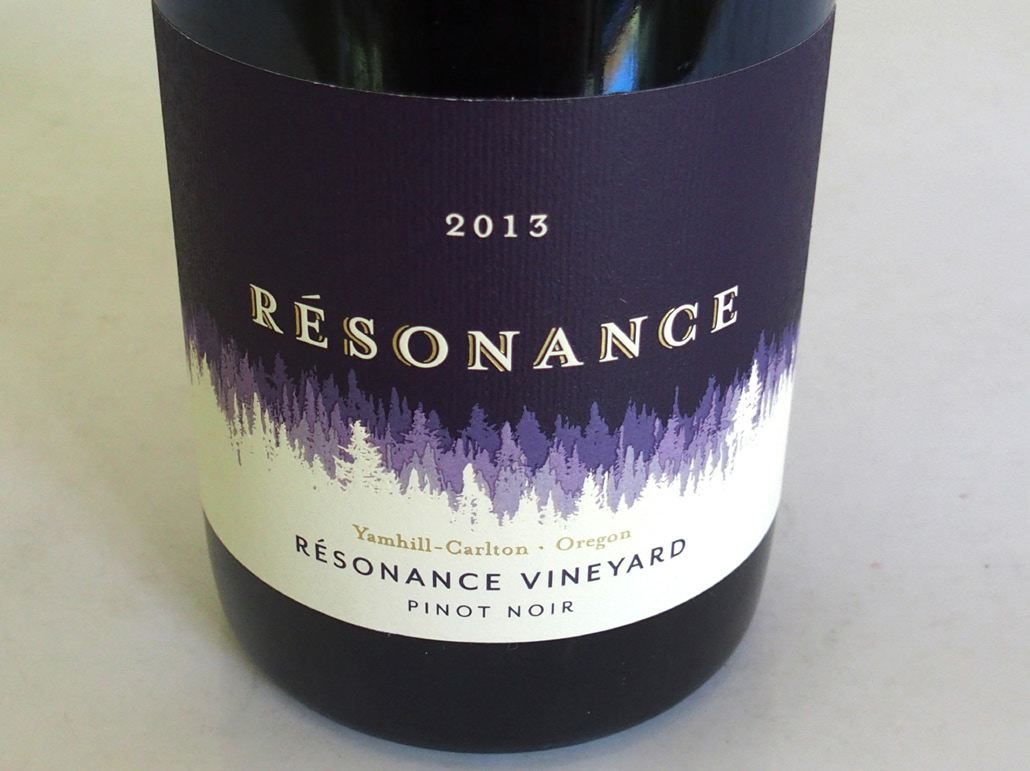
Domaine Roy & Fils, Dundee, OregonThis winery was started in 2012 with Marc-André Roy and Jared Etzel as noted previously in this article. The wines produced with the Domaine Roy & Fils label are made from estate vineyards. The Maison Roy & Fils wines are produced from non-estate fruit but made with the same uncompromising process. The Dundee Estate Vineyard and Winery consists of 13 high density acres of Pinot Noir and 2 acres of Chardonnay, planted on the site of a former hazelnut orchard and farmed organically. The vineyard is on a south facing hillside at 400 to 600 feet elevation in volcanic soil embedded with basalt rock. The inaugural vintage from the Dundee Estate will be 2015. The Carlton Estate Vineyard consists of 24 acres of Pinot Noir and 2 acres of Chardonnay that is farmed organically. Elevation ranges from 360 to 550 feet with south and east exposures. Soils are marine sedimentary speckled with crystalline quartz. The inaugural vintage from the Carlton Estate will be 2016.
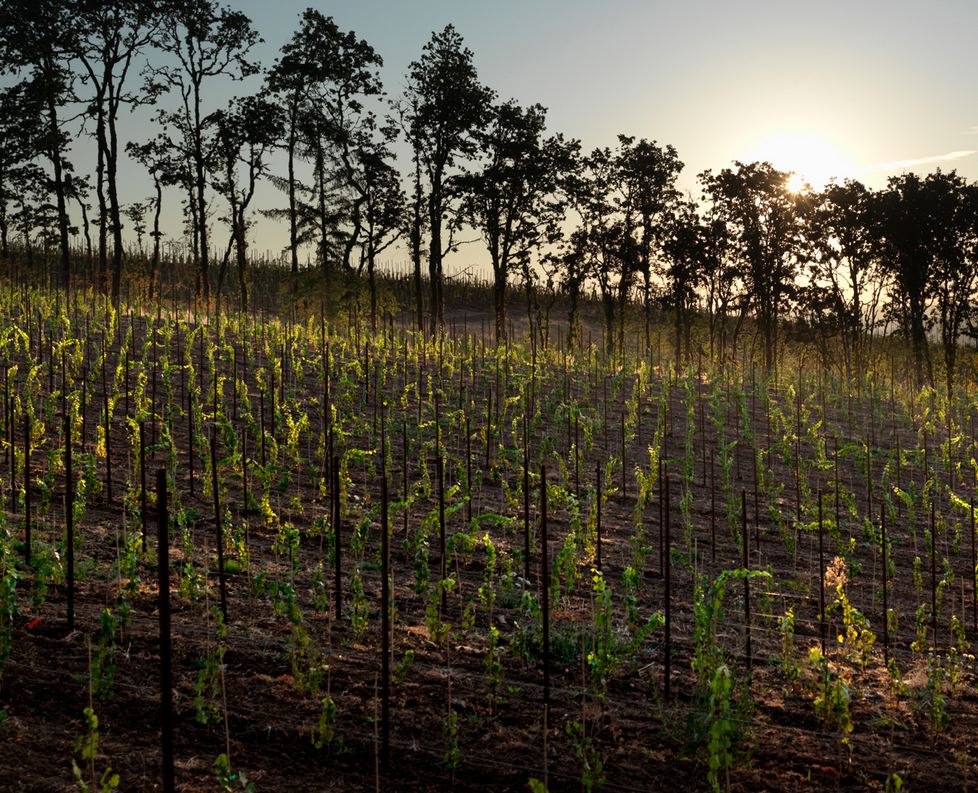 The production of the estate wines will be small and therefore allocated through a mailing list at www.domaineroy.com.
2014 Maison Roy & Fils Petite Incline Willamette Valley Oregon Pinot Noir 14.5% alc., pH 3.55, TA 0.59, $35. Sourced from six vineyards (Gran Moraine, Terry, Merrimen in the Yamhill- Carlton AVA and La Collina, Stoller and Kelly in the Dundee Hills AVA). Unfined and unfiltered. · Moderate reddish purple color in the glass. Shy aromas of dark cherry, blackberry and rose petal lead off. Plush and husky in the mouth, with plenty of black raspberry, blackberry and cassis flavors in a mid weight plus style. Still a bit tight and moody, but offering good balance and a sweet blackberry finish. When tasted the following day from a previously opened and re-corked bottle, the nose was still shy, and the husky tannins remained evident. This wine should evolve with more time in bottle. Score: 90
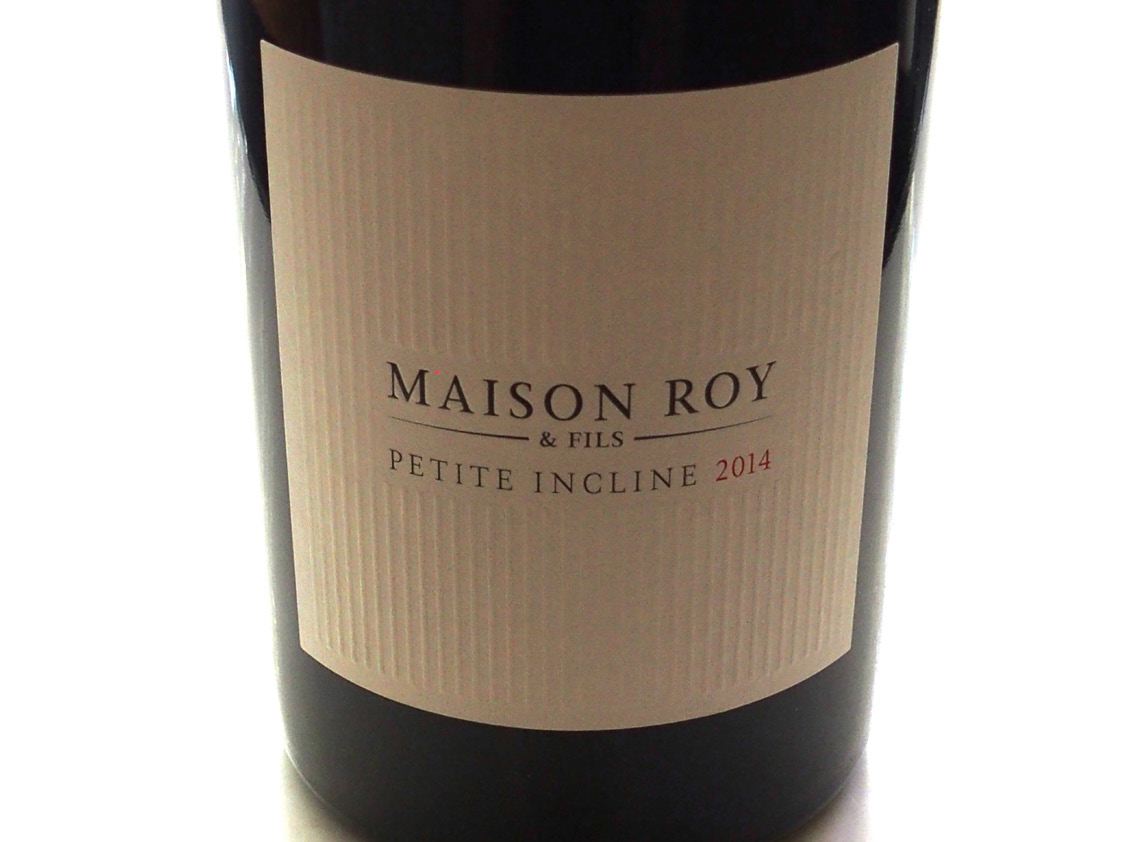 Final thought. Oregonians are doing a fine job with Pinot Noir on their own thank you, but the French offer a different take on Oregon Pinot Noir that will undoubtedly prove interesting, and every serious pinotphile should welcome the potential for stylistic diversity.
Jackson Family Wines Infuses New Life into Zena Crown VineyardPremier Pacific Vineyards developed Zena Crown Vineyard located just west of Salem, Oregon, in the Eola- Amity Hills AVA in the early 2000s, and it instantly became celebrated among producers such as Alexana Winery, Beaux Frères, Expression Wines, Penner-Ash Wine Cellars, Soléna and Soter Vineyards who released Zena Crown vineyard-designated Pinot Noirs. In 2013, Jackson Family Wines purchased the 115-acre Zena Crown Vineyard, that includes Zena East, West and Middle, representing part of the company’s initial foray into the Willamette Valley. With the 2013 vintage, Zena Crown Vineyard became a domaine and label, releasing less than 1,000 cases from the most expressive and distinctive blocks of the vineyard. Zena Crown Vineyard is located on a southwest facing slope of weathered and well-drained volcanic soils at the southern end of the Eola-Amity Hills AVA. The vineyard is a fairly uniform and harmonious site but the vineyard’s 17 blocks each have their own twists of aspect, depths of soil and grade changes. Elevation increases from 300 feet at the base of the slope to 650 feet at the vineyard’s high point offering a distinctive crown of conifers. The vineyard is planted to a rich diversity of Pinot Noir clones, including Dijon, Pommard, Wädenswil 2A, Mt. Eden, and Archery Summit clone 2 (“828”). It is the diverseness of the vineyard and clones that provides the opportunity to produce distinctive block-driven wines.
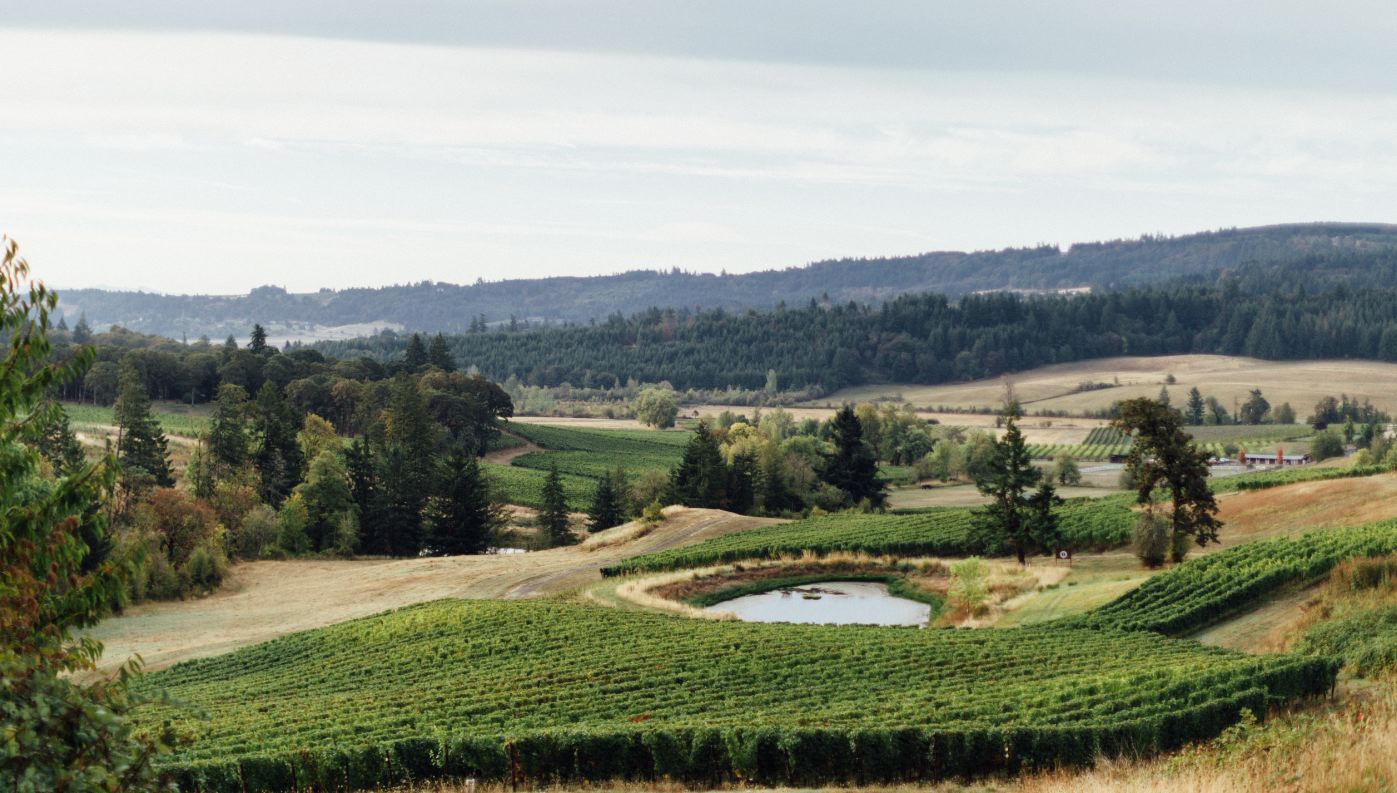 Zena Crown Vineyard is surrounded by the vineyards of Bethel Heights, Cristom and St. Innocent wineries, and sits adjacent the Van Duzer Corridor, a gap in the Coast Range that funnels cold Pacific winds into the Eola- Amity Hills. The result is small berries with thick skins, structured tannins, buoyant acidity, and slow ripening, with the region consistently the last to be harvested each vintage in the Willamette Valley. Renowned veteran Oregon winemaker Tony Rynders is the consulting winemaker and is teamed with Shane Moore, who relocated to Oregon leaving a position as associate winemaker for La Crema in California. Moore comments about his approach in Oregon, “You have to adapt and let the environment sculpt the wines, rather than enforcing established dogma or systems upon it. I never thought I would pick on emotion before arriving here. The Willamette Valley is not an environment for safe or clinical winemaking...we listen to the vineyard, and we adapt.” Winemaking might incorporate some percentage of whole clusters in the fermentation depending on the vintage, the clone, and the intended wine. Aging and malolactic fermentation occur in French oak barrels, 75% to 90% new depending on the wine and year. The wines are never racked until bottling. After a year and a half in oak, the wines are bottled with a Diam closure and are unfined as a rule. I found that the oak was perfectly integrated in these wines and I didn’t even mention oak in my review notes. How inviting!
2013 Zena Crown Vineyard Conifer Eola-Amity Hills Oregon Pinot Noir 13.0% alc., pH 3.65, TA 0.52, 240 cases, $75. A blend of Zena East Block 12 and Zena West 1A and 14. These blocks include 114 and “828,” and Pommard, all seven years old. Harvest Brix 20.5º-22.5º. Aged 17 months in French oak barrels, 75% new, medium to medium plus toast. · Moderate reddish purple color in the glass. Seductive perfume of cherry, strawberry, forest floor and spice lingering in the glass over time. Satiny on the palate, with a mid weight core of delicious dark red and black fruit flavors supported by elegant tannins. As the name implies, there is a conifer thread in the background. Very fresh, and everything is in its place, with a highly enjoyable but not exceptionally intense finish. Score: 92
2013 Zena Crown Vineyard The Sum Eola Amity Hills Oregon Pinot Noir 12.9% alc., pH 3.65, TA 0.50, 302 cases, $75. A blend of multiple clones from several vineyard blocks. This wine represents the sum of the land. 40% whole cluster fermentation. Clones 777, Pommard and 667, seven years old. Harvest Brix 22.1º-22.5º. Aged 17 months in French oak barrels, 71% new, medium to medium plus toast. · Moderate cherry red color in the glass. The whole cluster endows this wine with a gorgeous nose, offering hi-tone aromas of black cherry, forest floor, spice cabinet and rose petal. The cherry fruit takes on a darker and deeper aroma over time in the glass. Both red cherry, strawberry and darker fruits such as boysenberry provide nuance as does a savory note. The texture is particularly tantalizing, as is the lingering finish that seems to last until the next sip. Score: 93
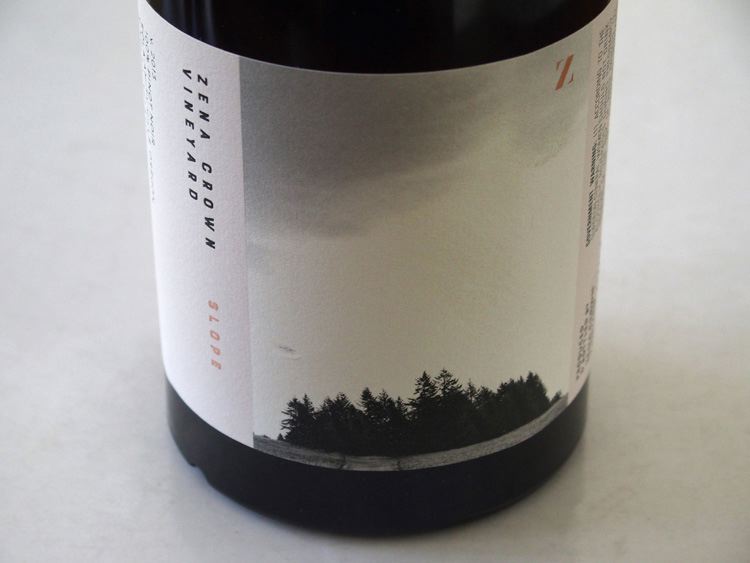 2013 Zena Crown Vineyard Slope Eola Amity Hills Oregon Pinot Noir 12.7% alc., pH 3.65, TA 0.53, 348 cases, $100. Sourced from Zena East blocks 5 and 6 that stretch from the highest point of the vineyard at 600 feet down to areas of lower elevation. Clone 667, seven years old. Harvest Brix 22.2º-22.7º. Aged 17 months in French oak barrels, 85% new, medium to medium plus toast. · Moderately dark reddish purple color in the glass. You need to be sitting down when you drink this beauty. Pleasant aromas of earth-kissed black cherry, crushed berries and mushrooms. Upon entry, there is an explosion of purple grape and berry flavor that is eye-opening. The sappy fruit saturates the palate with goodness, carrying through to a finish that displays uncommon intensity and length. Even better the following day when tasted from a previously opened and re-corked bottle when the aromas and flavors became exhumed in an orgasmic display. Score: 97
Sips of Recently Tasted California Pinot Noir
Brack Mountain Wine Company, SebastopolBrack Mountain Wine Company was founded in 2008 as a family owned and operated winery, producing a modest 500 cases annually, but has grown in recent years. The winery’s focus is small production, terroirdriven wines from small, interesting, preferably family owned vineyard sites across Sonoma County, Anderson Valley and Santa Lucia Highlands, offering a sense of place at accessible prices. All vineyards that the winery works with are 100% sustainably farmed and the viticulture protocols are closely maintained by vineyard manager Arturo Robledo. Brack Mountain’s founding winemaker is Dan Fitzgerald. A Northern California native, he lived in Europe for 13 years and developed an affinity for balanced, lower alcohol wines in the New World tradition. He began his winemaking career in 2002 in the Dry Creek Valley of Sonoma County, not far from Brack Mountain’s Enos Estate Vineyards. He worked back-to-back harvests in two hemispheres over three years before earning a Bachelor of Science degree in Enology from Fresno State University. After graduation, he worked with winemaker Bob Cabral at Williams Selyem Winery as well as obtaining winemaking experience at James Halliday’s Coldstream Hills Winery in Australia’s Yarra Valley, and Robert Sinskey Vineyards in Napa Valley. Before joining Brack Mountain as Partner and Director of Winemaking, Dan was Head Winemaker at Pellegrini Family Vineyards in the Russian River Valley.
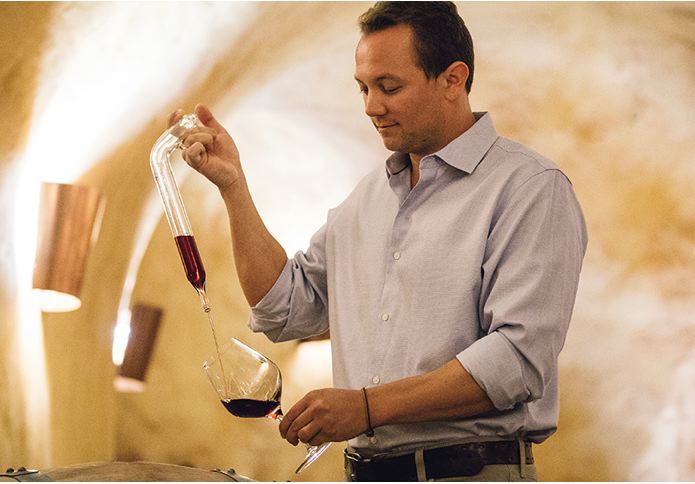 Winemaking involves gravity-flow wine movement, feral primary and secondary fermentations, and minimal handling and movement of the wines. Stylistically, the goal is earlier pick dates and resultant lower alcohols, along with well-integrated barrel selections. The entire lineup of Pinot Noir wines offer solid quality and value, with four of the wines offered at reasonable prices.They are food-friendly wines that will perform beautifully at the table. The Daniel label offers exceptional quality at an understandably higher price. Visit www.brackmountainwine.com. Pinot Noir is also offered under the Barrique and Matia labels.
2014 L’Oliveto Russian River Valley Pinot Noir 13.6% alc., pH 3.59, TA 0.64, $26. Sourced from Hurst Vineyard in the Sebastopol Hills and Cousins Vineyard in the central Russian River Valley. 66% de-stemmed, with 33% whole cluster added to the bottom of the tank. 5-day cold soak, feral fermentations. Aged 11 months in French oak barrels, 30% new. · Moderately light reddish purple color in the glass. Shy, but pleasant aromas of cherry and woodshed. Soft and velvety in the mouth with a modestly concentrated core of cherry and cranberry fruits framed by a woody thread. Easy to drink, with well-concealed tannins and a short finish. Score: 88
2014 Borne Mile Marker 33.89 Anderson Valley Pinot Noir 13.6% alc., pH 3.56, TA 0.66, $32. Sourced from Ferrington and Beaujolais vineyards. 70% de-stemmed with 30% whole cluster added to the top of de-stemmed fruit. Cold soak, feral primary and malolactic fermentations, aged 11 months in French oak barrels, 30% new. · Moderate reddish purple color in the glass. A wellappointed wine with aromas and flavors of cherry, red berry, spice and nutty oak. An elegantly composed, straight forward wine with redeeming balance. Score: 89
2014 BENCH Sonoma Coast Pinot Noir 13.8% alc., pH 3.57, TA 0.68, $24. Sourced primarily from the Sangiacomo Amaral Ranch Vineyard located north of San Pablo Bay, combined with a small amount of Vines and Roses Estate Vineyard in the Russian River Valley. 70% de-stemmed, long cold soak, feral primary and malolactic fermentations, aged 11 months in French oak barrels, 30% new. · Moderately light cherry red color in the glass. Cherry and cranberry fruit are front and center in this light to mid weighted wine that is pleasantly forward drinking, finishing modestly but with verve. Score: 89
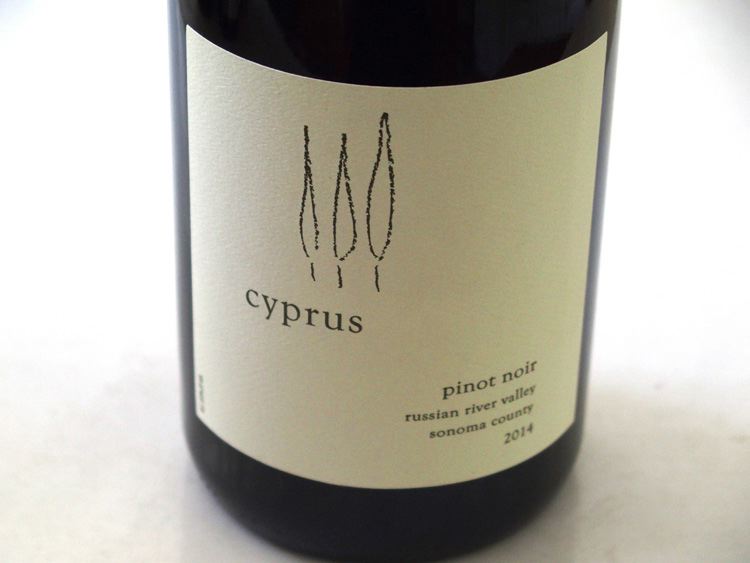 2014 Cyprus Russian River Valley Pinot Noir 13.8% alc., pH 3.54, TA 0.68, 766 cases, $30. Sourced from Hurst vineyard located in the Sebastopol Hills of the Russian River Valley. Goldridge soil. Feral primary and malolactic fermentations. Aged 11 months on the lees in French oak barrels, 33% new. · Moderate reddish purple color in the glass. Cordial aromas of red cherry and red berry with a hint of spice and cola typical of Russian River Valley Pinot Noir. Nicely composed, discreetly concentrated and very congenial on the palate with some length and generosity on the finish. Score: 90
2014 Daniel Grand Vent Vineyard Sonoma Coast Pinot Noir 12.9% alc., pH 3.57, TA 0.64, 90 cases, $60. Sourced from a 15-acre vineyard located in the Petaluma Gap. A cool maritime climate and cold winds lead to extended hang times lasting into mid to late October. Feral primary and malolactic fermentations in open-top stainless steel tanks. Aged 10 months in French oak barrels, 40% new. · Moderately dark reddish purple color in the glass. Irresistible aromatic presence featuring scents of black cherry, black raspberry, spice, earth and mulch. A luscious array of dark stone and berry fruits saturate the mid palate with goodness. A bit of savoriness displayed by spice, pepper and forest flora add interest. The silky mouthfeel is highly seductive and the rewarding finish is ornate and persistent. Score: 92
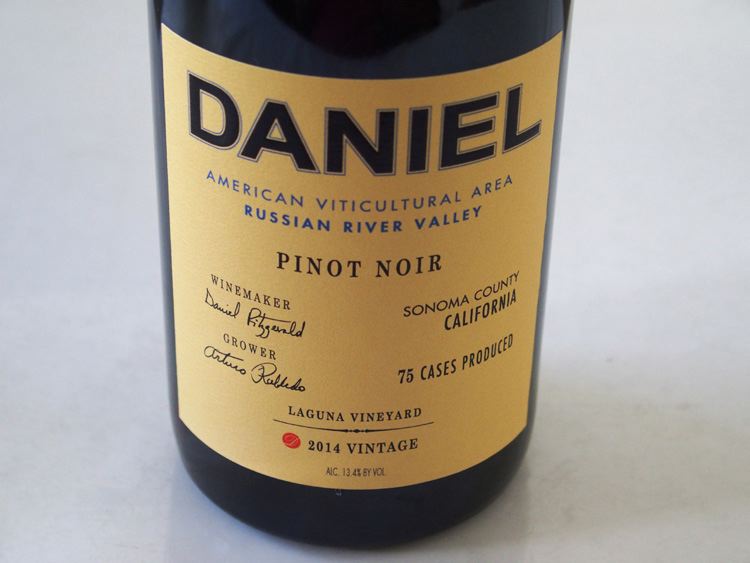 2014 Daniel Laguna Vineyard Russian River Valley Pinot Noir 13.4% alc., pH 3.61, TA 0.67, 75 cases, $60. This vineyard was planted in 2008 by proprietor and vineyard manager Arturo Robledo and his son, Arturo, Jr.. Goldridge soil. The vines are trellised a mere 24” off the ground and are organically farmed. Clones are Calera, Mt. Eden and Martini. 66% de-stemmed with 33% left whole cluster and added to the bottom of the tank. 5-day cold soak, feral primary and malolactic fermentations, aged 10 months on the lees in French oak 500 L puncheons, 33% new. · Moderately dark reddish purple color in the glass. Inviting aromas of Bing cherry, raspberry and dried herbs draw you into the glass. A forceful attack of delicious dark cherry fruit expands in the mouth, carrying over to a finish with respectable intensity and a burst of acidity. Score: 92
2014 Daniel Ferrington Vineyard Anderson Valley Pinot Noir 12.9% alc., pH 3.57, TA 0.64, 90 cases, $60. Feral primary and malolactic fermentations, aged 10 months in French oak barrels, 40% new. · Moderately dark reddish purple color in the glass. A complex wine with an array of ripe fruit aromas and flavors including plum, blueberry, black cherry and boysenberry. Amazing phenolic ripeness at this low ABV. The wine is blessed with deft barrel management, integrated ripe tannins and a lip-smacking finish. Score: 92
Eric Kent Wine Cellars, Santa RosaI first learned of Eric Kent Wine Cellars in 2005 when this winery, that began with a modest 375 cases in 2003, was a new adventure for winemaker Kent Humphrey, who had left behind a successful career in advertising. He chose to produce Pinot Noir, Chardonnay and Syrah since those were the varietals that gave him the most personal pleasure. Kent and his spouse, Colleen, an accomplished artist, decided one day over a dinner of hamburgers and Zinfandel, to feature artists on their bottles. The result has been a series of striking labels designed by deserving, but yet undiscovered talent. Each artist brings a unique vision that compliments the spirit behind the wine, adding another dimension to the wine by stimulating a discussion with every cork pulled. The label art by artist V De Montrand on The Pianist below:
 Kent has refined his winemaking over the past ten years, adding variety to his stylistic lineup. The 2014 wines I have reviewed here are among the best he has yet to release and that is saying something since I have reviewed almost every Pinot Noir Kent has produced. The wines are sold primarily through a mailing list with limited retail distribution. Visit www.erickentwines.com.
2014 Eric Kent The Pianist Sonoma Coast Pinot Noir 13.2% alc., pH 3.55, TA 0.62, 95 cases, $52. Released spring 2016. Winemaker Hanna Chort has worked four harvests at Eric Kent as well as crushes in Oregon, Australia and Argentina). This is a wine she can call her own creating a special blend each year. The name reflects here background as an accomplished classical pianist. Sourced from Grand Vent Vineyard (50%) in the Petaluma Gap and V-C Ranch (50%) in Freestone near Occidental. Clones Pommard (83%), 113 (10%) and 667 (7%). Aged in French oak barrels, 25% new. · Moderately light reddish purple color in the glass. Demure aromas of cherry and woodland forest pick up intensity over time in the glass. Light to mid weight delicate flavor of red cherry essence has hint of oak. A feminine-styled wine, yet packs plenty of flavor. Bashful tannins and redeeming balance make for easy enjoyability. Score: 91
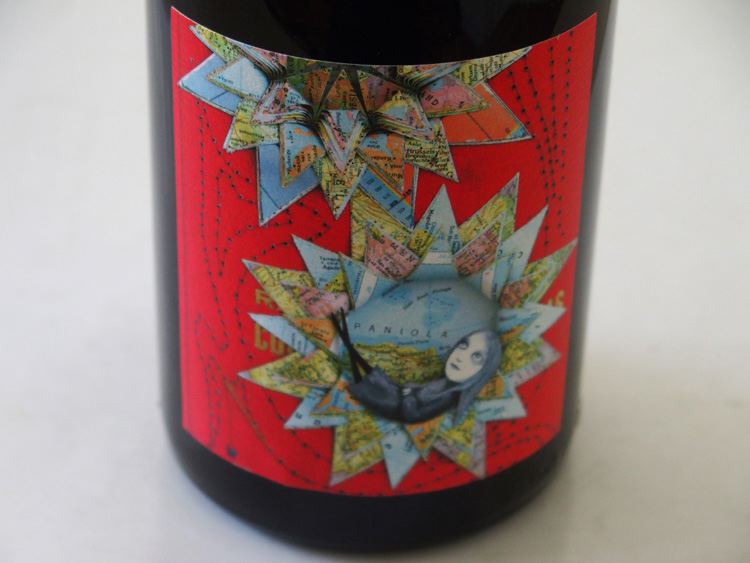 2014 Eric Kent Sascha Marie Sonoma Coast Pinot Noir 14.4% alc., pH 3.71, TA 0.60, 306 cases, $52. Sourced mainly from Roberts Road Vineyard located in the eastern Petaluma Gap region combined with contributions from four other sites. 56% Roberts Road, 16% Stiling, 16% Grand Vent, 8% V-C Ranch and 4% Rayhill. Clones are 44% Swan, 28% 777, 18% Pommard, 4.5% 115, 3% 113 and 2.5% 667. Aged in French oak barrels, 60% new. · Moderate reddish purple color in the glass. Flirtatious aromas of cherry pie, hazelnut and baking spices. Plenty of sappy Bing cherry fruit accented with spice. Sleek and forward drinking in a mid weight plus, generously fruity style that extends enough juicy acidity for admirable balance. This wine has that charming pinotosity that is impossible to describe but you know it when you experience it. Score: 94
2014 Eric Kent Small Town Sonoma Coast Pinot Noir 12.9% alc., pH 3.58, TA 0.62, 150 cases, $50. Released spring 2016. Sourced from four vineyards all owned by the Cleary family (60% Michael Valentine, 20% Stiling, 10% Cleary Ranch, 10% Roberts Road). Clones are 65% 667, 25% Swan, 5% 115 and 5% 777. 15% whole cluster fermentation. Aged in French oak barrels, 40% new. · Moderate reddish purple color in the glass. A mix of cherry and berry aromas lead off. Engaging flavor and phenolic ripeness despite the low ABV. A mix of black raspberry and boysenberry fruit offers tantalizing juiciness and the right touch of oak. The tannic backbone is perfectly integrated, and the startling finish has a captivating intensity that is rarely met with. Score: 93
Flying Goat Cellars, LompocVeteran winemaker Norm Yost is one of the original garagistes operating out of the Lompoc “wine ghetto.” He produces ultra premium, small lots of Pinot Noir and sparkling wine from vineyards in Santa Barbara County and San Luis Obispo County. The name of the winery bears explanation. While living in Oregon, Norm had trouble keeping the wild blackberry vines in his backyard under control before a friend suggested he acquire a pair of goats to fend off the vines. Norm bought two pygmy goats named “Never” and “Epernay,” and in short order found they not only ate the blackberry vines, they ate everything. They were also a source of comical entertainment with their spiral loops, flipper turns and straight-legged leaps. When Yost moved to California’s south Central Coast, he started an unnamed winery. He agonized over a name that would reflect the quality of his wines as well as avoid the stuffy attitude adopted by many wine producers, so he decided to name his new project after his kids. In this case, his “kids” were his two goats he brought with him from Oregon, and the name Flying Goat Cellars was chosen. The Flying goat label is a whimsical rendering of a horned goat flying over a moonlit mountainside surrounded by a crescent moon with six stars twinkling amidst a red and black checkered border. The labels have never changed.
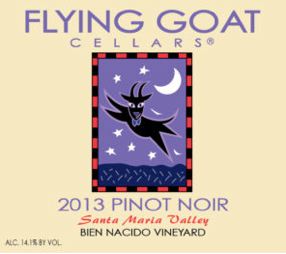 Flying Goat Cellars Pinot Noir may seem a bit whimsical, but the wines are seriously outstanding unencumbered by pretense. They are known to be quite drinkable upon release, yet age magnificently. Many of Norm’s vineyard sources have been long standing so he has an experienced feel in how to best vinify the fruit from these sites. Taste for yourself at the Flying Goat Cellars Tasting Room in the Lompoc Wine Ghetto, Thursday through Monday, or other days by appointment. Visit www.flyinggoatcellars.com.
2012 Flying Goat Cellars Dierberg Vineyard Santa Maria Valley Pinot Noir 14.7% alc., pH 3.65, TA 0.59, 304 cases, $46. Released October 4, 2014. This 161-acre vineyard was planted in 1997 in mostly sandy loam soils. Clone 115. Harvest Brix 24.7º. · Moderately dark reddish purple color in the glass. Intense perfume of oakkissed berries, cherries and raisin. The mid weight core of dark red and black berries are framed by a nutty oak overlay that is not oppressive. The tannins are gentle, and there is some length on the finish. A bit too ripe for my taste, but well crafted in this style. Score: 89
2012 Flying Goat Cellars Bien Nacido Vineyard Santa Maria Valley Pinot Noir 14.5% alc., pH 3.71, TA 0.53, 158 cases, $60. Released October 4, 2014. Martini clone from original 1973 own-rooted plantings. Harvest Brix 23.8º. · Moderate reddish purple color in the glass with very slight bricking of the rim. Ultra ripe, even roasted fruit aromas and flavors. The wine seems older than its years, with the black cherry and black berry fruits a bit tired and flat. Some tertiary characters are beginning to emerge. Score: 87
2012 Flying Goat Cellars Solomon Hills Vineyard Santa Maria Valley Pinot Noir 14.5% alc., pH 3.68, TA 0.66, 201 cases, $42. Released February 7, 2015. Solomon Hills Vineyard was planted in 1999 and is under the stewardship of the Miller Family who also farm Bien Nacido Vineyard. This wine is 100% Dijon clone 113. Harvest Brix 24.2º. · Moderate reddish purple color in the glass. I wish this wine had less oak influence because otherwise it is perfectly fine. Aromas of cherry, raspberry, sandalwood and toast lead to a middleweight styled wine with flavors of black cherry and dark red berry framed by gentle tannins. Silky in the mouth with some finishing intensity marred by a trail of conspicuous oak. Score: 89
2012 Flying Goat Cellars Rio Vista Vineyard 2A Sta. Rita Hills Pinot Noir 14.8% alc., pH 3.74, TA 0.59, 180 cases, $42. Released April 4, 2015. This vineyard is located at the eastern gateway to the Sta. Rita Hills AVA and is slightly warmer during the growing season than vineyards further west. Wädenswil 2A clone. Harvest Brix 26.7º. 100% de-stemmed, aged in French oak barrels, 30% new and 70% neutral. · Moderate reddish purple color in the glass. Deeply perfumed with aromas of cherry and rose petal. Very tasty essence of ripe strawberry and cherry with an enhancing spice note. A very comfortable wine with tannins folded in and impressive length of finish featuring generous cherry goodness. Score: 92
2012 Flying Goat Cellars Rancho Santa Rosa Vineyard Sta. Rita Hills Pinot Noir 14.6% alc., pH 3.42, TA 0.67, 151 cases, $48. Released April 4, 2015. Sourced from a vineyard owned by Foley Family Wines located on Highway 246 between Buellton and Lompoc. Flying Goat has sourced grapes from this vast 225-acre vineyard since 2002. Clone 667. Harvest Brix 24.0º. · Moderately dark reddish purple color in the glass. Quite ripe and dark fruited, with aromas and flavors of blackberry jam and cassis. Full-bodied, with a luscious core of black fruits accented with exotic spices. Captivating fruit presented in a beautifully balanced wine with good verve and length. Score: 92
2012 Flying Goat Cellars Bassi Ranch Vineyard San Luis Obispo County Pinot Noir 14.7% alc., pH 3.67, TA 0.58, 150 cases, $38. Released February 7, 2015. The Bassi Ranch Vineyard was formerly named Salisbury Vineyard. It is located two miles from the Pacific Ocean near Avila Beach. Soils are well-drained clay loam. A very cool site with consistent temperatures throughout the growing period. Clones 667 and 2A. Harvest Brix 24.7º. · Moderately light reddish purple color in the glass. An exotic nose with generous aromas of cherry, cardamom spice and wood pile. Sleek and suave in the mouth, with fruit flavors of cherry and cranberry robed in gentle tannins. The wine is a delight to drink, displaying a cherry-fueled, albeit oak-infused finish. Score: 90
2013 Flying Goat Cellars Goat Bubbles Santa Barbara County Brut Cuvée Sparkling Wine 12.8% alc., pH 3.20, TA 0.82, 207 cases, $42. Released April 4, 2015. In celebration of 10 years of Goat Bubbles, this inaugural Brut Cuvée was released. A blend of 80% Wädenswil 2A from Rio Vista Vineyard and 20% Chardonnay clone 15 from Sierra Madre Vineyard. Harvest Brix 20.3º. · Moderate golden yellow color in the glass. Enticing aromas of green apple, green herbs, roasted nuts and freshly baked bread with a good bead. Very dry, with a lemon, green apple and vanilla flavor profile. The tight, palate-cleansing finish is ideal. Score: 91
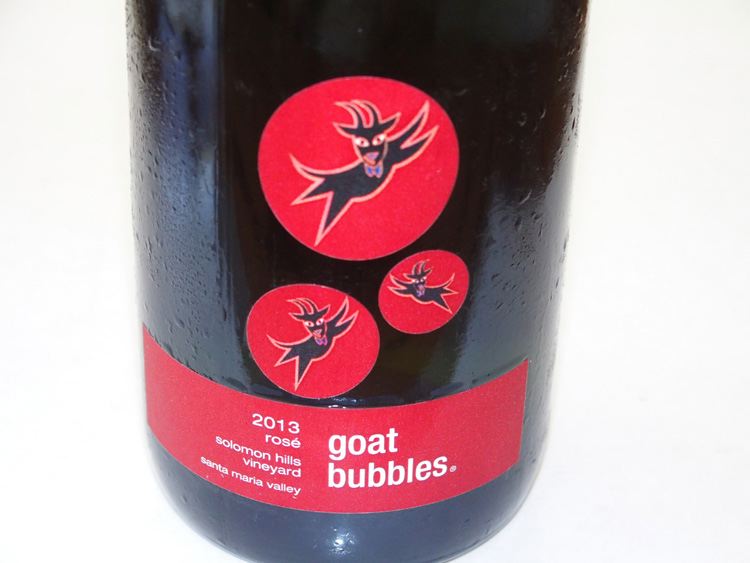 2013 Flying Goat Cellars Goat Bubbles Solomon Hills Vineyard Santa Maria Valley Rosé Sparkling Wine 12.9% alc., pH 3.03, TA 0.98, 271 cases, $42. Released February 7, 2015. Clone 23. Harvest Brix 19.0º. Whole cluster pressed and vinified as if a Rosé still wine. After 10 months aging in neutral French oak barrels, the wine was decanted into sparkling wine bottles, a tirage of sugar and yeast added, and a crown cap applied. After 6 months of aging and riddling, the wine was disgorged. · Moderately light orange color in the glass. Exuberant aromas of cherry, peach and yeast. Highly pleasing in the mouth, with a generous offering of blood orange and cranberry flavors. Thoroughly dry, with the orange thread persisting through the long finish. The most provocative sparkling wine of the three tasted on this date. Score: 92
12.9% alc., pH 3.08, TA 0.95, 143 cases, $42. Released October 3, 2015. Made from Chardonnay clone 15 from Sierra Madre Vineyard. Harvest Brix 20.4º. · Moderate cantaloupe color in the glass. Aromas of cherry, peach, pear and yeast are echoed on the dry palate. The wine offers a soothing texture, and a dry finish with citrus highlights and good length. Score: 90
Fogline Vineyards, FultonPartners Brent Bessire and Evan Pontoriero launched Fogline Vineyards in 2009 to produce small lots of Pinot Noir, Zinfandel, Syrah and Chardonnay. The cool-climate Fogline Home Vineyard is at the top of Sonoma Mountain at 900 feet elevation in the Petaluma Gap region and is planted to Pinot Noir and Chardonnay. The Pinot Noir is a field blended block composed of Mt. Eden, 115 and Pommard clones. Chardonnay is Dijon 76 and Old Wente clone. Pinot Noir is also sourced from Starscape Vineyard (formerly Floodgate Vineyard) in the Russian River Valley and Sun Chase Vineyard in the Petaluma Gap region of the Sonoma Coast. A winery and tasting room is located on River Road in Fulton across the street from where the original Williams Seleym garage winery was located. The Fogline Vineyards building has a long history of winemaking in the Russian River Valley. Check with the winery regarding tasting room hours. Visit www.foglinevineyards.com.
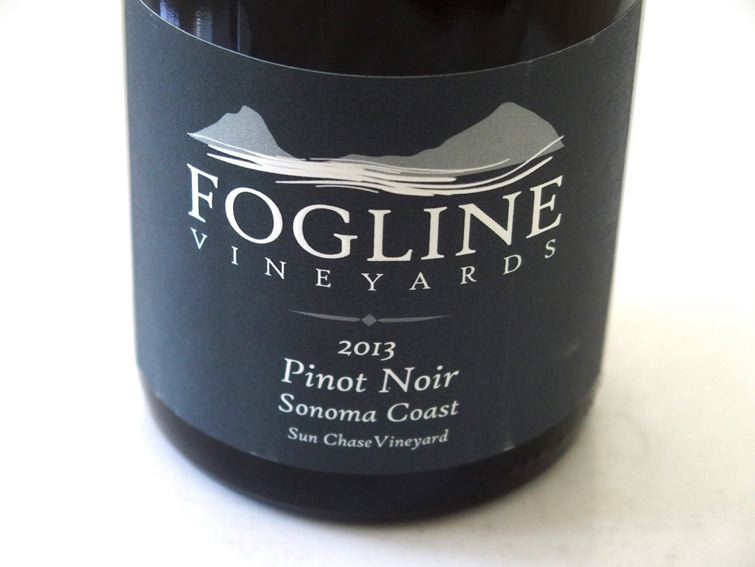 2013 Fogline Vineyards Sun Chase Vineyard Sonoma Coast Pinot Noir 14.0% alc., pH 3.60, TA 0.60, 245 cases, $42. This 40-acre, sustainably-farmed vineyard is located where the Petaluma Gap meets Sonoma Mountain, perched at 900 to 1,400 feet elevation on a southwestern facing hillside. Clones 667 and 777. Aged in French oak barrels, 33% new. · Moderate crimson color in the glass. Aromas of black cherry, sous-bois and oak lead to a mid weight style wine with enticing flavors of black cherry, black raspberry, boysenberry and spice with a deft touch of oak in the background. Charming, with balanced ripe tannins, and irresistible juicy vibrancy. Score: 92
2013 Fogline Vineyards Floodgate Vineyard Russian River Valley Pinot Noir 14.0% alc., pH 3.60, TA 0.65, 225 cases, $42. This organically certified vineyard is located in the Middle Reach just off River Road. Beginning in 2014, the name will change to Starscape Vineyard due to an ownership change. Clones 667, 777, 115 and Pommard. Fermented with a commercial strain of malolactic bacteria known to produce low biogenic amines. Aged in French oak barrels, 30% new. · Moderate reddish purple color in the glass. Brooding, but pleasant aromas of Bing cherry, earthy flora and spice. Riper and richer than the Sun Chase bottling, with a hedonistic core of spiced black cherries accented with a cola note, and framed by structured tannins. Wellcrafted, with good finishing intensity. My only nit would be that the fruit has a slight roasted, compote character. Score: 90
Vaughn Duffy Wines, Santa RosaFounder and winemaker Vaughn Duffy was a wine salesperson when he fell in love with Pinot Noir. He worked a harvest at Siduri and launched his professional winemaking career at Vinify, a custom crush winery. In 2009, together with his spouse, Sarah Vaughn, bought one ton of Pinot Noir grapes and made their first wine under the Vaughn Duffy Wines label. Another story of first-generation winemaking families taking the plunge. Tastings are available by appointment in Santa Rosa. If I had to relate the style of the Pinot Noirs, I would say they are very close to Kosta Browne. Visit www.vaughnduffywines.com. One added note regarding the label and the orange wax capsule on the bottle. I told Matt that some people love it and others find it weird. He told me the following. "Ahhh, the label… Yes, we have found that some (most) people dig it and some do not. I feel like the response is mostly positive, or at least inquisitive. When I worked at a bottle shop, I learned the importance of getting the bottle to standout and that if the customer picked up the bottle, they usually bought it… So what better to grab attention than a funky label with bright orange wax on top? The label depicts a forklift carrying two barrels of wine. The forklift represents where I was when we made our first wine: working as a cellar rat, driving the forklift around the winery where I worked to make things go, go, go… The two barrels represent our first vintage: 2009 Pinot Noir from Suacci Vineyard. The forklift is also a symbol of the hard work behind the scenes that it takes to make these wonderful wines. As for the rest of the label and the “feeling,” let’s just say that Sara and I are big San Francisco Giants fans and we used to go a lot of shows at the Fillmore when we first met in San Francisco. All those old concert posters must have rubbed off on us."
2015 Vaughn Duffy Wines Sonoma County Rosé of Pinot Noir 13.9% alc., pH 3.17, TA 0.74, 616 cases, $20. Released March 2016. Saignée method. 80% Pinot Noir, 16% Syrah and 4% Zinfandel. 80% aged in neutral French oak barrels, 20% in stainless steel. No malolactic fermentation. · Moderate watermelon color in the glass. Aromas of strawberry, apple, straw and nuts lead off. More engaging on the palate, with a variety of fruit flavors showing up including cranberry, watermelon, apple and blood orange augmented nicely by a savory herbal and nutty tone. A good acid underbelly keeps the wine fresh and vibrant. Score: 89
2015 Vaughn Duffy Wines Russian River Valley Pinot Noir 14.0% alc., $36. A blend of several vineyard sources. · Dark reddish purple color in the glass. A bit youthful and clumsy, but the potential is evident. The aromas of black cherry liquor and orange zest are shy and the full-bodied flavors of black cherry and black raspberry are not as expressive as they will be. Deeply concentrated fruit with balanced tannins and a vibrant acid backbone. The finish is particularly intense and persistent. Score: 91
2014 Vaughn Duffy Wines Russian River Valley Pinot Noir 14.3% alc., pH 3.53, TA 0.60, 225 cases, $36. Released November 2015. A blend of four vineyards (50% Stori, 33% Desmond, 12% Wren Hop and 5% Suacci). Clones 115, 777 and 667. Vineyard ages 12-15 years. Soils are Goldridge. Bottled unfined and unfiltered. · Moderate reddish purple color in the glass. The nose initiates a favorable impression with aromas of black cherry, spice and vanilla. Generously endowed with black cherry fruit that is accented with flavors of cola and spice. Nicely balanced and forward drinking, with a sweet cherry cordial finish. Score: 90
2014 Vaughn Duffy Wines Suacci Vineyard Sonoma Coast Pinot Noir 13.9% alc., pH 3.55, TA 0.64, 88 cases, $50. Released March 2015. Sourced from a sustainably-farmed, 6.5-acre vineyard located southwest of Sebastopol just 10 miles from the Pacific Ocean. The vineyard was planted in 1993 by Charlie Chenoweth to clones 115 and 777. Harvest Brix 24.1º (115) and 24.4º (777 and 115). Hill Block (115) 100% de-stemmed. Apartment Block (115 and 777), co-fermented the two clones, 30% whole cluster. Aged 10 months in French oak barrels, 33% new. Bottled unfined and unfiltered. · Dark reddish purple color in the glass. The aromatics expand over time in the glass, offering hi-tone scents of black cherry, black raspberry, potpourri and a hint of peppery spices. The flavors echo the nose with a bit of toasty oak seasoning evident in the background. Middleweight in style, with integrated tannins, a silky texture and an engaging finish of uncommon length. Score: 92
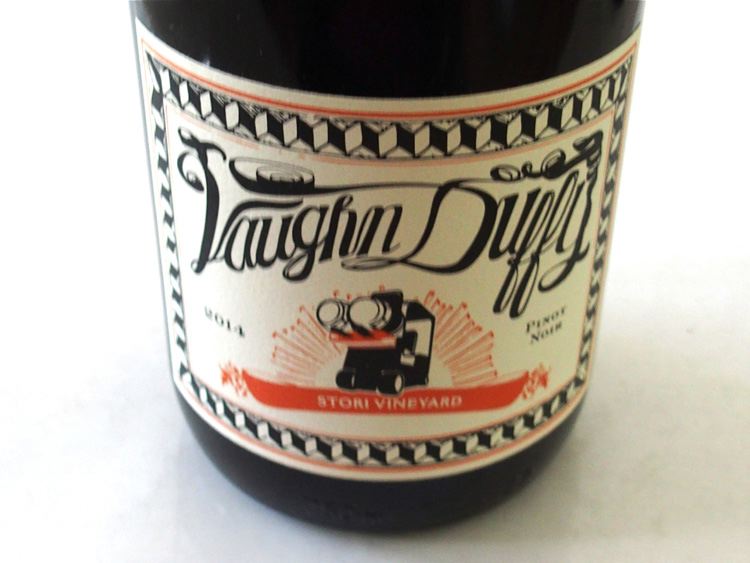 2014 Vaughn Duffy Wines Stori Vineyard Green Valley of Russian River Valley Pinot Noir 14.1% alc., pH 3.57, TA 0.59, 74 cases, $48. Released September 2016. The 2.25-acre Stori Vineyard was planted in 2001 to clone 115. Soils are Goldridge. 100% de-stemmed, 6-day cold soak, feral yeast fermentation. Aged 17 months in French oak barrels. A selection of the three best barrels out of twelve. · Moderately dark reddish purple color in the glass. Initially moody, but opening nicely over time in the glass to revealing engaging aromas of dark stone and berry fruits and spice. A full-bodied core of charming black cherry, black raspberry and blueberry fruit flavors back by spice really draw attention. Impeccable balance, offering both fruit generosity and suavity, finishing on point. This wine is clearly special. Score: 93
More Wines
2014 Carmel Road Monterey Pinot Noir 13.5% alc., TA 0.53, 51,389 cases, $25. Released March 2016. Sourced primarily from the Panorama Vineyard located in the foothills of the Arroyo Seco AVA, with additional contributions from Rincon Vineyard in Monterey and Clark Vineyard in Arroyo Seco. All vineyards certified sustainable by SIP since 2008. Aged 8 months in 97% French oak barrels. · Moderately light reddish purple color in the glass. This wine aims to please with ebullient aromas of cherry, spice and sandalwood and light to mid weight flavors centered on spiced cherry fruit. Easygoing, with cashmere tannins, a hint of oak seasoning, and a lingering, congenial finish. A great value. Score: 90
2013 Carmel Road Panorama Vineyard Monterey Pinot Noir 15.0% alc., pH 3.69, TA 0.56, 392 cases, $35. Released February 2016. This estate vineyard is located in the foothills of the Santa Lucia Mountains in the Arroyo Seco AVA. This certified sustainable vineyard is planted to high density spacing. Clones 667 and 777 with a small balance of “828.” 7-day cold soak, fermented in small open top fermenters, and aged 17 months in French oak barrels, 28% new. · Moderately dark reddish purple color in the glass. Very moody nose offering shy scents of dark fruits and wine cave. A mid weight assortment of well-ripened dark fruits are at the wine’s core, framed by matched tannins and proper acidity. The high alcohol is well integrated, the oak seasoning is spot on, but the wine is singing monotone offering nothing more than a sullen load of fruit. Score: 88
2013 Fog Crest Vineyard Estate Russian River Valley Pinot Noir 14.6% alc., $55. Estate bottled. · Moderate reddish purple color in the glass. Deep Bing cherry and blackberry aroma with a hint of brewed tea and cola. Richly appointed and very ripely fruited, with mid weight plus flavors of black cherry, black currant, rhubarb and cola. Lush on the palate with matching firm tannins, good acidity and generous toasty oak in the background. The wine finishes with an intense fan of cherry fruit. Well-done in this style. Score: 90
2014 La Crema Russian River Valley Pinot Noir 14.5% alc., pH 3.60, TA 0.57, 10,146 cases, $40. Sourced from 14 grower and estate vineyards spread across the Russian River Valley AVA including the sub-AVAs of Chalk Hill and Green Valley. Clones 777, Flowers, Pommard, Wädenswil 2A, 667, “828,” and 23. 100% destemmed with 70% whole berries in the tank. 3 to 5-day cold soak, fermented in open top tanks. Aged in French oak barrels, 38% new. No racking out of barrels until blending before bottling. · Moderate cherry red color in the glass. Welcoming aromas of cherry and baking spices. A streamlined style that is both sleek and suave, with discreetly weighted flavors of cherry and red plum. The tannins are well integrated, the oak adds the right amount of seasoning, and the delightful finish is blessed with a generous presence of juice cherry fruit. Score: 91
2013 Papapietro Perry Leras Family Vineyard Russian River Valley Pinot Noir 13.5% alc., pH 3.60, 1,275 cases, $58. 13-year-old Pommard clones, and newer vine clones including Beringer Heritage, 115, 667 and 777. Harvest Brix 23.9º. 2-3 day cold soak, several inoculated yeasts cultured specifically for Pinot Noir. Aged at least 11 months in Francois Frères French oak barrels, 40% new, 40% 1-year-old and 20% 2-year-old. · Moderate reddish purple color in the glass. Aromas of cherry, rose petal and pine sap lead to a discreetly concentrated core of red cherry, cranberry and pomegranate fruit flavors accented with plenty of spice and a thread of oak in the background. The wine is fueled with citrus-driven acidity that is evident on the slightly tart finish. Score: 90
2014 Tongue Dancer Pinot de Ville Putnam Vineyard Sonoma County Pinot Noir 14.5%, pH 3.73, TA 0.57, RS <1.0 g/L. 70 cases, $65. Released September 6, 2916. Inaugural single-vineyard Pinot Noir release from Tongue Dancer Wines. This historic 32-acre vineyard was planted in 2005 at 500 feet elevation and is located in Annapolis on the West Sonoma Coast, just 6 miles inland from the Pacific Ocean. The vineyard is family owned and operated by Cliff and Puanani Putnam. Goldridge and sandy clay loam soils. Clones 115, 777, Pommard, Flowers, Calera. Yield 2.0 tons/acre. 100% de-stemmed after meticulous sorting. 5-day cold soak, native and inoculated yeast primary fermentation. Once fermentation close to completion, the fermenters are drained of free-run juice to barrel and barrels are stirred once every other week until primary is completed. The wine was aged 18 months on the lees in French oak barrels. Light filtration with no fining at bottling. · Moderate reddish purple color in the glass. A vivacious wine with an array of aromas including dark berries, black cherry, black raspberry, spice and dusty earth. A wild, feral character enhances the mid weight core of dark red and black berry and spice flavors. Lifted by good acidity, with judiciously integrated oak, and offering a notably seductive satiny mouthfeel. The wine was more expressive the following day when re-tasted from a previously opened and re-corked bottle. Score: 91
2014 Wedell Cellars Sta. Rita Hills Rosé of Pinot Noir 13.5% alc., 12 cases, $12. Harvest Brix 24.5º. A saignée from 14 vineyard blocks and clones from four vineyards that the winery sources grapes from: Fiddlestix, Sanford & Benedict, La Encantada and Rancho La Vina. Fermented in neutral French oak barrels for 2 weeks, then aged on lees in these barrels for 15 months. 100% malolactic fermentation. Gently filtered. All proceeds from sale of this wine go to breast cancer charity. · Moderate pinkish orange color in the glass. Pungent, with some volatile acidity initially, becoming more pleasing over time in the glass offering aromas of peach, pastry cream and roasted nuts. Soft and smooth on the palate, with flavors of red berry, pomegranate, blood orange and strawberry, finishing with a lift of acidity. Score: 87
2010 Wedell Cellars Hillside Vineyard Edna Valley Pinot Noir 14.5% alc., pH 3.26, TA 0.67, 90 cases, $125. The 3-acre Hillside Vineyard was planted in 1995 in the southeastern end of Edna Valley with clones 115, 667 and 777 on low vigor rootstock. It was planted to a vine density of almost 2,000 vines per acre. Yields in 2010 were under 1.75 tons per acre. Harvest Brix 24.3º. 100% de-stemmed, all free run discarded. 3-day cold soak, cool fermentation with feral yeast, aged on lees in 48-month air dried, 3 new and 1 neutral French oak barrels for 21 months. Only racking occurred with bottling in August 2012, unfined and unfiltered. · Moderately dark reddish purple color in the glass. Aromas of blackberry, cassis, dark chocolate and a subtle char note lead off. The mid weight plus core of black fruits have an earthy tone with an oak-driven note of dark cocoa contributing. The tannins have melded but are still evident, the oak is supportive, and the velvety mouthfeel is seductive. This wine has aged nicely and will certainly hold a few more years. Score: 90
Pinot Briefs
California Wine Institute Offers SB County Road Trip The Wine Institute’s California Wines Road Trips series highlights Santa Barbara County this month. Nearly 200 wineries are found among six AVAs which are part of the larger Central Coast AVA. Browse the list of Santa Barbara County wineries at www.discovercaliforniawines.com and use the interactive map to search wineries by amenities. The Santa Barbara County Vintners Association at www.sbccountywines.com also features in in-depth wine country touring guide and tow-for-one tasting passes for purchase online, as well as fee tasting route maps to nine wine trails. Santa Cruz Mountains November Passport Day On the third Saturday of January, April, July and November, Passport participants are welcomed into 50+ wineries throughout the Santa Cruz Mountains. The November event will be on Saturday, November 19, 2016. Passports are valid for two years and are $55. Visit www.scmwa.com. Charles Banks Sells Sandhi Wines Banks, the former owner of Screaming Eagle, has sold Sandhi Wines to co-founders Rajat Parr and Sasha Moorman, and venture capitalist Steve Webster. Sandhi, located in the Sta. Rita Hills, was established in 2009 to produce high-end, terroir-driven Pinot Noir and Chardonnay. Davis Family Vineyards Strikes Gold & Double Gold at 2016 Sonoma Harvest Fair Former PinotFile “Winery of the Year,” Davis Family Vineyards, was awarded seven Gold Medals and Three Double Gold Medals (every judge awarded it a Gold) at the annual Sonoma Wineries-only blind judging. 195 local wineries entered 1,094 wines. Double Gold Medals were awarded to the 2015 Davis Family Vineyards Chardonnay(not released, $38), the 2013 Davis Family Vineyards Horseshoe Bend Pinot Noir ($55) and the 2013 Davis Family Vineyards Campbell Ranch Pinot Noir ($65). The 2014 Davis Family Vineyards Horseshoe Bend Pinot Noir ($55), 2013 Davis Family Vineyards Sonoma Coast Pinot Noir, and 2015 Davis Family Vineyards Russian River Valley Cote Rosé ($25) won Gold Medals. Red Wine Sweepstakes winner was the 2014 Russian River Vineyards Horse Ridge Vineyard Russian River Valley Pinot Noir ($65). Best of Class Pinot Noir went to 2014 Inspiration Vineyards & Winery Inspiration Vineyards Russian River Valley Pinot Noir ($36), 2014 Russian River Vineyards Horse Ridge Vineyard Russian River Valley Pinot Noir ($65), and 2015 St. Francis Winery & Vineyards Pinot Noir ($22). For a listing of all the medal winners, visit www.harvestfair.org. UC Davis Releases Survey Results to be Reported at Wine Industry Financial Symposium in September The 14th annual wine executives survey revealed the following: (1) Millennials are consuming more and higher-value wines, driven by a thirst for quality, new experiences and information-sharing; (2) Concerns over water availability is causing wine executives to buy only vineyards with good access to water, choosing water-efficient rootstocks, and investing in technology to minimize water use in the vineyard and winery; (3) Anticipating climate change that may intensify in the coming years, wine executives said that they are now looking outside of California to Oregon and Washington for vineyard development and to Chile, Argentina and Australia for sourcing bulk wine; (4) Consolidation of wine distributors and mergers and acquisitions within the industry are continuing trends (see also www.pressdemocrat.com/ business/6130695-181/winery-mergers-and-acquisitions-expected (5) The improving economy and increased DTC sales would have the greatest positive effect California wine sales over the next three years. Labor shortages would have a large negative effect California wine sales during the same period; (6) Industry professionals projected that over the next three years the strongest red wine varietals will be Cabernet Sauvignon, followed by Pinot Noir and red blends. They anticipated that the top white varietals will be Chardonnay and Sauvignon Blanc, followed by Pinot Gris. ¡Salud! Salutes 25th Anniversary Winemakers from Oregon’s foremost wineries will debut the 2015 vintage at this benefit for Oregon’s seasonal vineyard workers and their families. This event is the only opportunity to acquire unique cuvées made exclusively for ¡Salud! The ¡Salud! Cuvée Tasting and Big Board Auction will be Friday, November 11, 2016, from 3:00 p.m. to 6:30 p.m. at Ponzi Vineyards (tickets are $275 each). The following evening, Saturday, November 12, 2016, will be the 25th Anniversary Celebration Gala and Auction at the Sentinel Hotel in Portland (tickets are $295 each). Weekend ticket bundles are $500 each. Accommodations at the Sentinel are available at a special discounted rate. Visit www.saludauction.org.
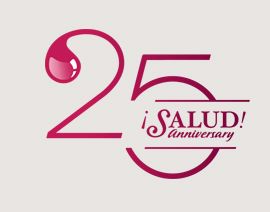 Sta. Rita Hills AVA Expansion Approved In August, 2016, the TTB approved a petition to expand the Sta. Rita Hills AVA. The petition had been submitted by three vineyard owners whose vines were just outside the AVA with Pence Ranch and John Sebastiano Vineyard the main supporters of the petition. There was fierce opposition from the board of directors of the Sta. Rita Hills Winegrowers’ Alliance. The expansion added 2,296 acres to the 33,380-acre Sta. Rita Hills AVA. Cheerwine: A Soda for Pinot Noir Lovers I recently discovered a non alcoholic soft drink that tastes just like Pinot Noir. L.D. Peeler created Cheerwine in 1917 in Salisbury, North Carolina, when a traveling salesperson from St. Louis sold his robust cherry flavor to the company founder, who wanted to add a cherry soda to the Carolina Beverage Corporation soda lineup to take advantage of the flavor’s popularity. Nearly 100 years later, Cheerwine is still a family owned business, with L.D.’s great grandson, Cliff Ritchie leading the company. Carolina Beverage Corporation and Cheerwine Bottling Co. is the oldest, continuously operated, family owned soft drink company. The name comes from the drink’s burgundy color and the cheerfulness drinkers experience after the first sip...which does sound like wine. It has also been called the “Nectar of North Carolina” and the “Legend.” Copy cats such as Cherry Coke and Wild Cherry Pepsi weren’t sold in stores until the 1980s, while Cherry Dr. Pepper arrived in the 2000s. Never duplicated, Cheerwine is available in 12 ounce bottles and cans, regular or diet in all 50 states (Only North Carolineans enjoyed Cheerwine until very recently). I prefer this black cherry bliss in the diet bottling since it has no sweetness and more duplicates the flavor of Pinot Noir.
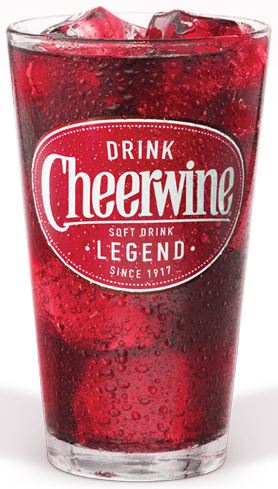
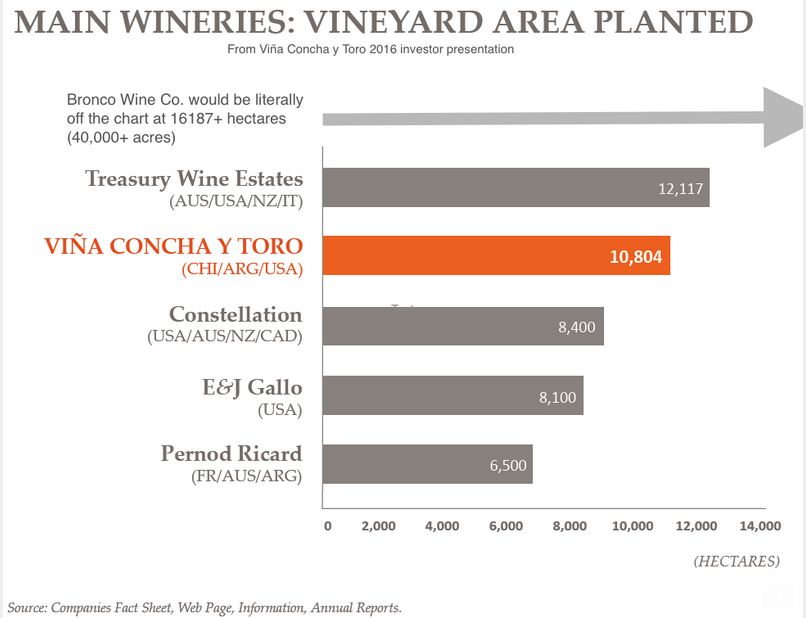 |